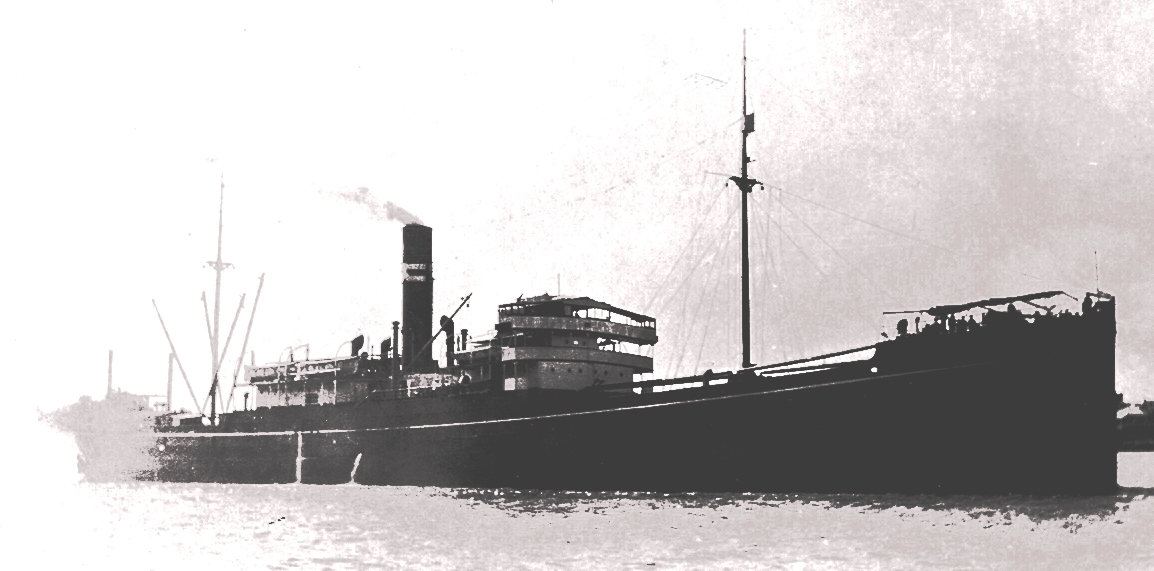RIKUGUN YUSOSEN
 (HIMALAYA MARU, prewar)
(HIMALAYA MARU, prewar)
HIMALAYA MARU:
Tabular Record of Movement
© 2012-2016 Bob Hackett
Revision 1
15 March 1918:
Nagasaki. Laid down at Mitsubishi Yososen, K. K. as Yard No.
278, a 5,229-ton passenger-cargo ship for the Osaka Shosen Kaisha (OSK) Line.
6 August 1918:
Launched and named HIMALAYA MARU.
29 August 1918:
Completed. HIMALAYA MARU can accommodate six 1st class
passengers and carries a crew of 48.
September 1918:
Enters OSK’s service on their South African route.
5 January 1920:
HIMALAYA MARU departs Moji for Germany repatriating
World War 1 German prisoners of-war (POWs) captured in 1914 at Tsingtao, China.
Five other Japanese ships make similar repatriation voyages to Germany.
1920:
Transferred to OSK’s Yokohama ~ Antwerp, Belgium route.
1923:
Transferred to OSK’s Yokohama ~ Calcutta, India route.
21 June 1927:
At 1045, HIMALAYA MARU departs Musgrave Wharf, South
Brisbane, Australia for Japan. At about 1100, she runs aground on the rocks near
Kangaroo Point. Later, she is pulled off by the stern a tug and proceeds without
suffering damage.
16 December 1941:
Requisitioned by the Imperial Army (IJA) and converted
to a troop transport. Alloted IJA No. 978.
17 December 1941: Operation "M" (M Sakusen) -The Invasion of the Northern
Philippines:
At 0900, HIMALAYA MARU departs Kirun, Formosa (Keelung, Taiwan)
for Lingayen Gulf, Philippines in Rear Admiral (later Vice Admiral) Rear Admiral
Hirose Sueto (39)(former CO of HARUNA) 3rd Lingayen Invasion Unit with 21 other
IJA transports escorted by DesDiv 9's YAMAGUMO, minelayer WAKATAKA and four
smaller warships.
The Japanese main invasion at Lingayen Gulf consists of three transport
echelons. The first is composed of 27 transports from Takao under Rear Admiral
Hara Kensaburo, the second of 28 transports under Rear Admiral Nishimura and the
third under Rear Admiral Hirose. This force of 76 transports carries the main
part of LtGen Homma Masaharu's 80,000-man 14th Army.
24 December 1941:
Between 0110 and 0430, the transports land their
troops at Lingayen.
1 March 1942: Operation "J" - The Invasion of Java, Netherlands East
Indies:
At 0120, 100 miles W of Surabaya, Java. The Eastern Java Invasion
Force now consisting of 43 transports including HIMALAYA MARU enters the
roadstead off Kragan village, East Java.
Just before dropping anchor, the ships suffer a fierce air attack. JOHORE
MARU is hit and suffers many KIA and WIA. TOKUSHIMA MARU is also hit and has to
be beached at 0200. Despite the air attacks, at 0015, the convoy lands the 48th
Infantry Division at Kragan village, East Java. Their main objectives are the
Surabaya Naval Base on the eastern coast and Tjilatjap harbor on the southern
coast.
March 1943:
HIMALAYA MARU departs Palau for Saeki in an unidentified
convoy also consisting of HAMBURG and SORACHI MARUs with an unknown escort.
31 March 1943:
YURIJIMA and auxiliary minesweeper TAKUNAN MARU No. 3
join the convoy at 29-23N 134-55E and escort it northwards.
1 April 1943:
The escorts are detached off Fukajima.
13 April 1943:
HIMALAYA MARU departs Saeki for Palau in convoy K-413
also consisting of DAIFUKU, HAMBURG, IKOMA, SORACHI and YOSHINO MARUs escorted
by torpedo boat HATO and patrol boat PB-46.
E 14 April 1943:
PB-46 is detached at 29N.
21 April 1943:
The convoy arrives at Palau. DAIFUKU MARU and torpedo
boat HATO are detached. IKOMA MARU departs for Wake Island. HIMALAYA MARU and
the others depart for Rabaul with an unknown escort.
E 28 April 1943:
Arrives at Rabaul, New Britain.
24 May 1943:
At 0600, HIMALAYA MARU departs Palau escorting convoy No.
3209 consisting of FUSEI (ex British FAUSANG), SHONAN, NIKKI, HAMBURG MARUs and
an unidentified merchant escorted by destroyer SANAE.
29 May 1943:
Arrives at Manila.
8 June 1943:
At 1500, HIMALAYA MARU departs Manila in convoy No. 3501
also consisting of AKASHI, HAMBURG, RONSAN, SHINNO and SHOSEI MARUs escorted by
kaibokan MATSUWA.
11 June 1943:
At 1600, RONSAN MARU is detached for Miri, Borneo at
10-48N 111-36E.
15 June 1943:
The convoy arrives at St Jacques, Vichy French
Indochina.
12 September 1943:
HIMALAYA MARU arrives at Singapore. [1]
6 October 1943:
Departs Singapore for Jakarta.
30 November 1943:
At 0300, HIMALAYA MARU departs Rabaul, New Britain
in a convoy consisting of AWA, NIKKI, SHINYU, SHOHO and WALES MARUs escorted by
subchasers CH-37 and CH-38. HIMALAYA MARU is carrying 2,564 passengers and crew
including men of the 14th Field Repair workshop, 16th Signals Regiment and 7th
Supply Hospital, 645 wounded servicemen and Korean and Japanese ‘comfort women’
(prostitutes).
S of New Hanover. At 2333, the convoy is attacked by a USN Consolidated
PBY "Catalina" floatplanes HIMALAYA MARU is hit by one of three incendiary bombs
and set afire. At 2315, Abandon Ship is ordered. At 2334, HIMALAYA MARU sinks at
02-47S, 150-25E. 27 soldiers, six crewmen and two comfort women are KIA. The
survivors are picked up by other ships in the convoy.
Author’s Notes:
[1] On 27 Sep ‘43, in Operation "Jaywick", the Royal
Australian Navy's (RAN) Special Operations Executive organized a limpet mine
attack on Japanese shipping at Singapore. The RAN used former Japanese fishing
boat KOFUKU MARU, renamed KRAIT. On 2 Sep, a small group of Allied servicemen
sailed from Exmouth Gulf, Western Australia through the Java Sea. On 18 Sep,
three two-man canoes launched a night attack at Singapore. HIMALAYA MARU,
although probably present, was not damaged in the attack. For more on this
see Peter Cundall's excellent
Operation "Jaywick"
Thanks go to Erich Muehlthaler of Germany.
-Bob Hackett
Back
to IJA Transports


. 


